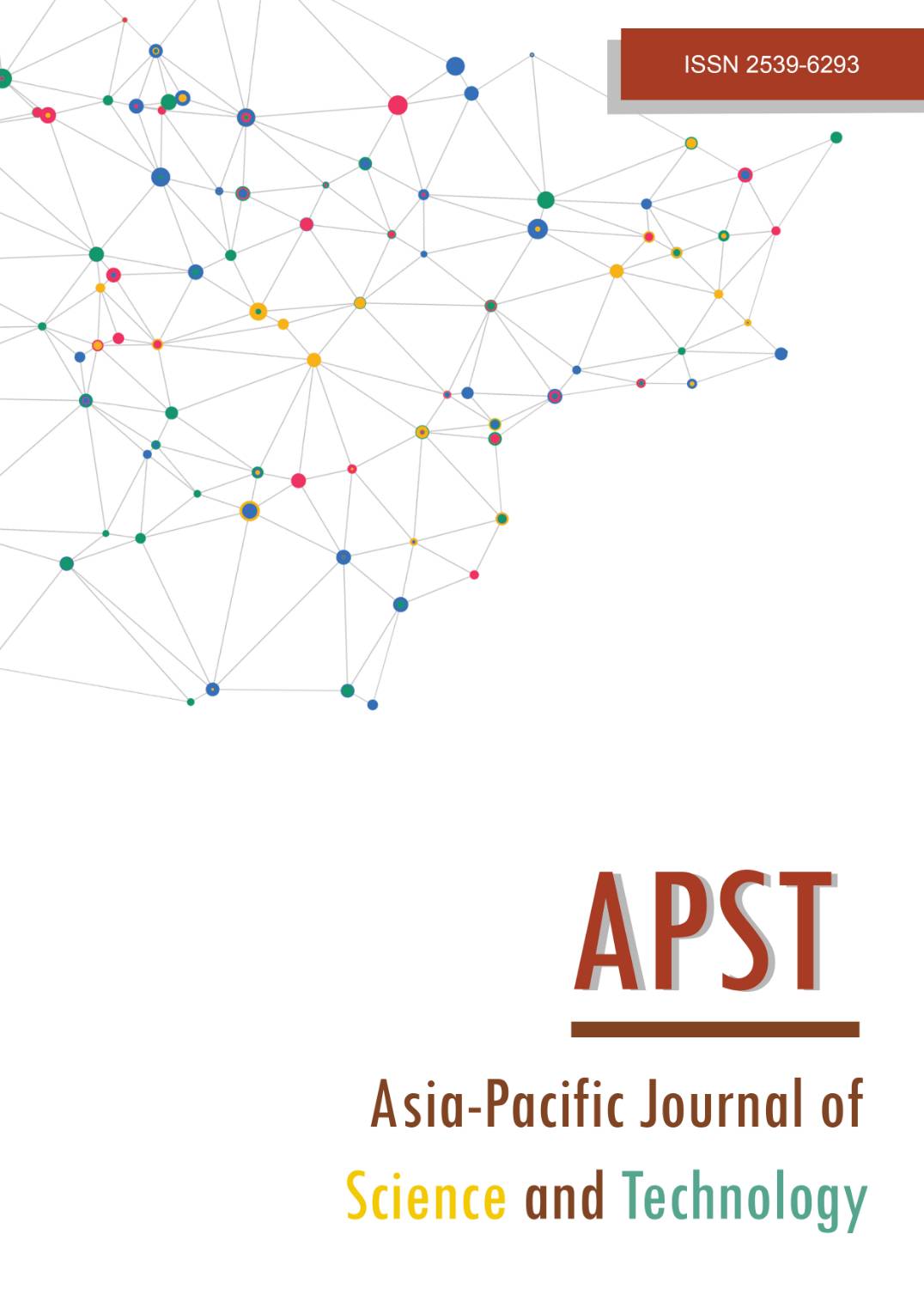The association between road traffic noise and annoyance levels in residential and sensitive areas of Ayutthaya, Thailand
Main Article Content
Abstract
In urban areas of Thailand, noise emission from road traffic has been found to be a serious concern among the general public. Therefore, socio-acoustic surveys of community response to road traffic noise were conducted to investigate annoyance level of people residing in sensitive and residential areas of Ayutthaya Municipality with a sample size of 265 respondents. Noise-sensitive receptors in this study included hospital, schools and temples. In addition, the relationship between the percentage of “highly annoyed” persons (%HA) and day-night noise levels (Ldn) were described using a dose-response curve. The results showed that road traffic noise levels in sensitive areas were greater than those in residential areas. Most measurement sites exceeded the national ambient noise standard, resulting in the number of individuals annoyed by road traffic noise totaling 75.1% of total respondents. However, highly annoyed persons were computed to be 23.1-37.5 and 30.0-40.0% of total respondents in residential and sensitively areas, respectively. When Ldn was greater than 70 dB(A), the %HA due to road traffic noise in sensitive areas was significantly higher than that in residential areas with the same Ldn. These indicated that people of Ayutthaya in sensitive areas were more sensitive to road traffic noise than those residing in residential areas. Therefore, mitigation measures to reduce road traffic noise should be implemented in these areas to prevent noise problems in urban communities.
Article Details
References
WHO. Burden of disease from environmental noise: quantification of healthy life years lost in Europe 2011 [Internet]. 2019 [cited 2019 Apr 5] Available from http://www.euro.who.int/__data/assets/pdf_file/0008 /136466/e94888.pdf.
Camusso C, Pronello C. A study of relationships between traffic noise and annoyance for different urban site typologies. Transp Res D Transp Environ. 2016;44:122-133.
Dzhambova A, Tilov B, Markevych I, Dimitrova D. Residential road traffic noise and general mental health in youth: the role of noise annoyance, neighborhood restorative quality, physical activity, and social cohesion as potential mediators. Environ Int. 2017;109:1-9.
Belojeviæ GA, Jakovljeviæ BD, Stojanov VJ, Slepceviæ VZ, Paunoviæ KZ. Nighttime road-traffic noise and arterial hypertension in an urban population. Hypertens Res. 2008;31:775-781.
Belojevic G, Jakovljevic B, Stojanov V, Paunovic K, Ilic J. Urban road-traffic noise and blood pressure and heart rate in preschool children. Environ Int. 2008;34:226-231.
Babisch W, Neuhauser H, Thamm M, Seiwert M. Blood pressure of 8-14-year-old children in relation to traffic noise at home-results of the German environmental survey for children (GerES IV). Sci Total Environ. 2009;407:5839-5843.
Basner M, Babisch W, Davis A, Brink M, Clark C, Janssen S, et al. Auditory and non-auditory effects of noise on health. Lancet. 2014;383(9925):1325-1332.
Ky NM. Community response to road traffic noise in Hue City, Vietnam. Environ Nat Resource J. 2014; 12:24-28.
DYNAMAP. DYNAMAP project [Internet]. 2020 [cited 2020 May 30]. Available from http://www.life-dynamap.eu/project/.
PCD. Air quality and noise [Internet]. 2020 [cited 2019 Apr 7]. Available from http://noisemonitor.net /web/download.php.
Bunnakrid K, Sihabut T, Patthanaissaranukool W. The relationship between road traffic noise and annoyance level in Phuket Province, Thailand. Asia Pac J Sci Technol. 2017;22(4):1-8.
National Statistical Office. Ayutthaya Province: 2016-2018 [internet]. 2019 [cited 2019 Jun 19]. Available from http://ayuttaya.nso.go.th/index.php?option=com_content&view=category&id=120&Itemid=507.
DOE. Environmental Noise Limits and Control [Internet]. 2020 [cited 2020 May 30]. Available from http://www.life-dynamap.eu/project/.
Lam KC, Chan PK, Chan TC, Au WH, Hui WC. Annoyance response to mixed transportation noise in Hong Kong. Appl Acoust. 2009;70:1-10.
Guski R, Felscher-Suhr U, Schuemer R. The concept of noise annoyance: how international experts see it. J Sound Vib. 1999;223(4):513-527.
WHO. Environmental health indicators: development of a methodology for WHO European Region. World Health Organization. Copenhagen: Denmark; 2000.
Yano T, Sato T, Bjorkman M, Rylander R. Comparison of community response to road traffic noise in Japan and Sweden. J Sound Vib. 2004;250:169-174.
Schultz TJ. Synthesis of social surveys on noise annoyance. J Acoust Soc Am. 1978;64,377-405.
Brink M, Schäffer B, Vienneau D, Foraster M, Pieren R, Eze IC, et al. A survey on exposure-response relationships for road, rail, and aircraft noise annoyance: differences between continuous and intermittent noise. Environ Int. 2019;125:277-290.
Wunderli JM, Pieren R, Habermacher M, Vienneau D, Cajochen C, Probst-Hensch N, et al. Intermittency ratio: a metric reflecting short-term temporal variations of transportation noise exposure. J Expo Sci Environ Epidemiol. 2016;26(6):575-585.
Praščević M, Mihajlov D, Cvetkovic D, Gajicki A. Long-term noise measurements and harmonica index as a way of raising public awareness about traffic noise in the city of NIŠ. Facta Univ Ser Work Living Environ Prot. 2017;14(1):41-51.
Paiva KM, Cardoso MRA, Zannin PHT. Exposure to road traffic noise: annoyance, perception and associated factors among Brazil’s adult population. Sci Total Environ. 2018;650:978-986.
Zytoon AM. Opportunities for environmental noise mapping in Saudi Arabia: a case of traffic noise annoyance in an urban area in Jeddah City. Int J Environ Res Public Health. 2016;13(496):1-19.
Zambon G, Roman HE, Benocci R. Vehicle speed recognition from noise spectral patterns. Int J Environ Res Public Health. 2017;11(4):449-459.
Zambon G, Roman HE, Benocci R. Scaling model for a speed-dependent vehicle noise spectrum. J Traffic Transp Eng. 2017;4(3):230-239.
TRSO. Speed of vehicle [Internet]. 2019 [cited 2019 Jul 15]. Available from http://trso.thairoads.org/statistic /risk/detail/5066.
Patthanaissaranukool W, Bunnakrid K, Sihabut T. Applying mathematical modeling to predict road traffic noise in Phuket Province, Thailand. Int J GEOMATE. 2019;62:133-139.
Ali SA, Tamura A. Road traffic noise levels, restrictions and annoyance in Greater Cairo, Egypt. Appl Acoust. 2003;64:815-23.
Renterghem TV, Botteldooren D. View on outdoor vegetation reduces noise annoyance for dwellers near busy roads. Landscape Urban Plan. 2016;148:203-215.
Jakovljevic B, Paunovic K, Belojevic G. Road-traffic noise and factors influencing noise annoyance in an urban population. Environ Int. 2009;35:552-556.


